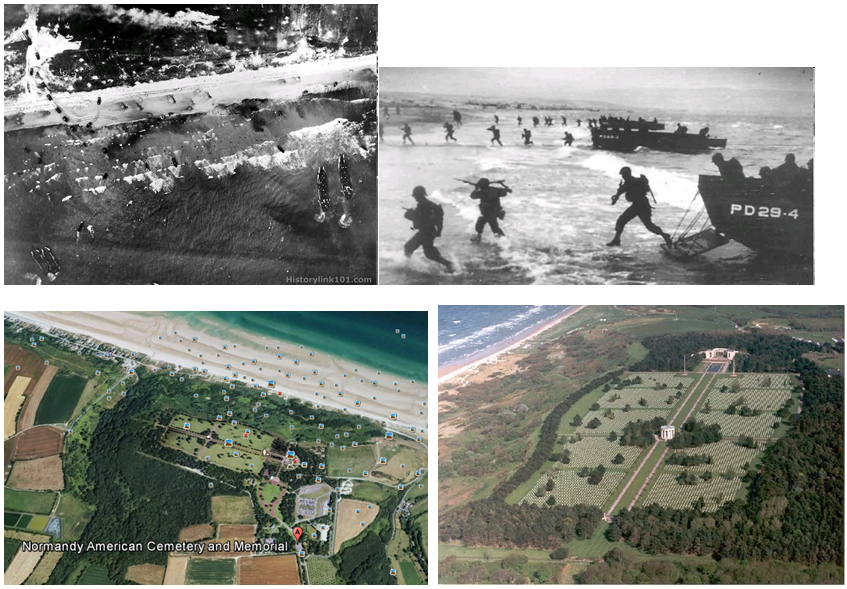D-Day Remembered
On June 6, 1944, selfless courage by free people on a colossal scale responded to a dozen years of European tyranny. Put the National D-Day Museum in New Orleans, LA on your historical travel plans.
Long before dawn, several hundred thousand Allied soldiers huddled aboard ships awaiting final orders to invade “Fortress Europe”. June 5 was the original date, but that optimal monthly combination of moon and tides was abandoned due to bad weather over the English Channel.
As the forecast weather appeared to clear, Supreme Allied Commander Dwight D. Eisenhower said “OK, let’s go!” rather than postpone another month. When three Airborne Divisions (two American and one British) including 100’s of gliders were dropped behind the Normandy beachhead, thousands of invasion ships were already launched. The goal was to land over a hundred thousand soldiers in France in the first 24 hours. There were five adjacent invasion beaches: two British, one Canadian, and two American. Operation Overlord on D-Day was the most massive sea invasion in military history.
By mid morning, four beaches reported light casualties and were secure when the American beach code-named Omaha was close to disaster! Thousands of soldiers of the Big Red One, the US Army’s First Infantry Division along with elements of the 29th Infantry Division were pinned down on the beach and taking heavy casualties. The 116th regiment of the 29th ID was practically wiped out by Germans fortified on the high cliffs (Pointe-du-hoc ) between the American beaches of Utah and Omaha. These enemy positions were raking soldiers disembarking from landing craft with lines of machine gun and mortar fire. When two Navy Destroyers firing point blank approached dangerously close to the beach, the enemy finally abandoned some positions from the edge of the cliffs. Then, elite soldiers from the US Army’s 2nd and the 5th Ranger battalions fired grappling hooks, scaled the cliffs, and overpowered the enemy positions.
D-Day to Paris
German General Erwin Rommel was in command of the defense of Western Europe, (and actually had left France to visit his wife) when the weather appeared to preclude an invasion. By the time Hitler was awakened and began to micro-manage the defense, the Allies had a firm beachhead and were connecting with the airborne units. Most of the mechanized Panzers that were intended to stop the Allies on the beach were delayed or destroyed by the enormous allied air cover. Within a month, those same fighter and bomber aircraft cleared the way for several allied armies of over a million men to move inland toward Paris.
“GI Joe” along with British “Tommy” slugged their way through hedgerows and villages toward Paris. The soldiers had no body armor or “up armored” jeeps. Every combat maneuver demanded personal risk with many sacrifices. The only real armor available to Allied soldiers was the Sherman tank, which was out gunned by both the German Panther and Tiger tanks. The Sherman had a tendency to burn and was nicknamed the “Ronson ” based on the lighter company’s slogan that “it lights every time”. Although the Sherman had advantages in sheer numbers and speed, its short barreled 75-mm main gun was well out of range when it was a prime target of a German 88 gun.
Nevertheless, with the overwhelming number of troops, aircraft, vehicles, and munitions flowing in from American factories, the destruction of the Western portion of the nazi war machine was just a matter of time. When asked what won the war in Europe, Eisenhower didn’t mention a single weapons system. He listed the Jeep, 6 by 6 truck, lumbering DC-3 transport airplane, Bulldozer, and the Higgins landing craft. All were designed to just get troops into combat. Ike knew that if the Allies could put the massive numbers of well-equipped forces in a fight, the Allies would win!
By D-day plus 70, with the help of the French underground, 40 Allied Divisions including a single free French Division (2nd Armored) were in France, with Paris itself ready for liberation. To their credit, the German leadership disobeyed Hitler’s orders for the destruction of Paris, and withdrew to fight another day. Then, the Allied troops stepped aside for a day of celebration, and Charles DeGaulle was given the honor of entering Paris in late August of 1944.
Western Europe Free
In spite of an additional 1 million fresh American combat troops staging from England, the war dragged on for nearly a year. There were future disasters such as when British General Montgomery tried to shortcut the route to Berlin with an airborne assault on Holland and a “Bridge too Far”. Later, Hitler’s counterattack through Ardennes before Christmas resulted in the Battle of Bulge. Of course, the whole time the Russians suffered enormous casualties grinding away from the East. WWII in Europe finally ended in May of 1945.
In 1966, Charles DeGaulle began to forget the history of that last century when he decided on a French independence from NATO. Secretary of State Dean Rusk’s reply when DeGaulle demanded all American soldiers removed from French soil. “..Does that include the thousands of Americans soldiers buried at Normandy and throughout France..?” Well, maybe not ALL the soldiers have to leave…”.
On this anniversary of D-Day let us never forget the leadership, bravery, and sacrifice that continue to secure our Liberty. Let us also remember our real friends and periodically remind our “fair weather” friends that: FREEDOM IS NOT FREE.

